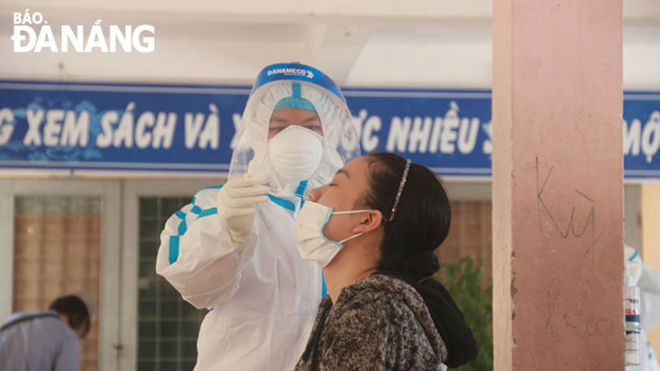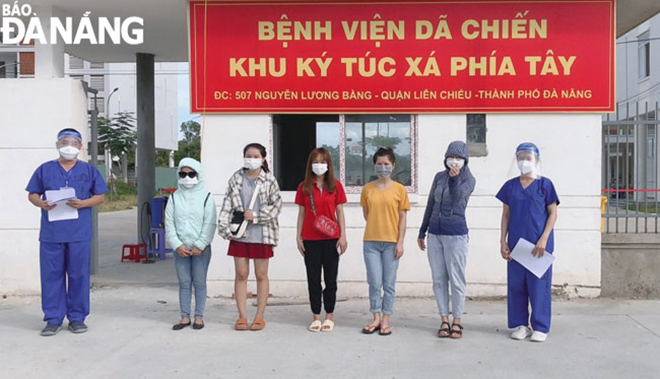Proactive measures against COVID-19: urgent must-do for Da Nang dwellers amid complicated virus threat
The developments of COVID-19 resurgence in Da Nang is still very complicated for the time being. Local medical forces are racing against time at the highest level of potential to detect and isolate positive cases from the community as soon as possible. According to professional assessment, the strain of the coronavirus causing infections in Da Nang has a very fast spread rate and those who contract with it may come in with critical illness. Therefore, proactively preventing COVID-19 from the beginning is an urgent must-do which medical experts recommend the public to fulfil.
 |
| The strain of the coronavirus causing infections in Da Nang has a very fast spread rate and those who contract may come in with critical illness. A local woman living a high-risk neighborhood in Son Tra District is seem having her nasal swab samples taken for COVID-19. Photo: PHAN CHUNG |
The virus spreads so fast, with shortened incubation cycle
According to the Da Nang for Disease Control (CDC), within just 5 weeks (from July 10 to now), about 2,000 COVID-19 cases have been reported in the city with community transmissions detected in its all districts. This highly concerning fact has created great pressure onto the healthcare system.
According to the latest statistics, more than 470 COVID-19 hotspots with clusters of positive cases have been spotted till date. Besides, the Da Nang CDC and the district-level medical establishments have jointly conducted the collection of swab samples for COVID-19 testing from more than 1 million citizens.
Currently, the local health sector has sent samples collected from clusters of COVID-19 cases in Da Nang to Ha Noi and Ho Chi Minh City for gene sequencing. Although no results have been released till date, CDC Da Nang assumed that the strain of the coronavirus that is raging the city for the time being, may be Delta.
It is scientifically known that the Delta variant’s transmissibility was also estimated to be 2 - 3 times higher than pre-mutation strains. For now, it remains the most transmissible of all variants identified.It could attach tightly to host cells, rapidly multiply in large numbers in the cells and then destroy the cells, and spread pathogens to the environment in a short time.
Worse still, Delta has shorter incubation period. A person could now infect others only 2 -3 days after catching the virus, not 4 - 5 days as before.
According to the CDC Da Nang’s calculation, with each infection cycle running in 2 - 3 days, a person infected with the virus can infect about 8 others. Therefore, if a positive case is missed in the community, after 3 infection cycles with a total of about 7 - 9 days, the number of new infections linked to the first case will be over 500.
In fact, the chains of COVID-19 infection that have been recorded in the past time have had a very large number of infections, notably the cluster founded at the Tho Quang fishing wharf with more than 1,000 cases.
Doctor Ton That Thanh, Director of CDC Da Nang said, “Another highly concerning point is COVID-19 infection within the family. This means that if only one member catches the virus, if not detected in time, most of the remaining ones in the family may be infected after 2 - 3 days. Currently, there are many cases under which all 8 - 10 people in one family are COVID-19 patients.
This fact shows that each individual needs to be seriously aware of pandemic prevention and control from the beginning. If any of us have contact and travel schedules related to positive cases, we should proactively make health declarations to the competent authority at the earliest”.
 |
| Locals are highly recommended to be still on high alert against the deadly virus. Five patients are discharged from the field hospital set at a dormitory complex to the west of the city following their full recovery from the disease. Photo: PHAN CHUNG |
Young people, without underlying medical conditions, still get worse
Currently, more than 1,200 COVID-19 patients are being treated in Da Nang, of whom 72 are in the Da Nang Lung Hospital, 205 in the Hoa Vang District Medical Centre and the rest are in a field hospital set at a dormitory complex to the west of the city.
According to Doctor Le Duc Nhan, Vice Chairman of a municipal council specialising in COVID-19 treatment, Da Nang is currently applying the stratification to treat COVID-19 patients at 3 levels under the direction of the Vietnamese Ministry of Health, respectively.
For the time being, 72 severe patients are being treated at the Da Nang Lung Hospital, of whom about 60 are classified into the at-risk, high- risk and severe-risk groups. There were 2 cases resorting to mechanical ventilation and extracorporeal membrane oxygenation (ECMO). Besides, some cases are now requiring invasive mechanical ventilation and continuous dialysis, dialysis machine ventilation, nasal mask frames and other intense care services.
The worrying thing at this time is the growing rate of young patient coming into severe and critical cases, and at the same time warning of the rapid spread and rapid progression of severe disease in conditions.
As compared to the previous ones, this ongoing coronavirus wave is witnessing many young patients in their thirties, without underlying medical conditions still get worse at a very quick pace with the severe lung damage, though their health status was completely good. Therefore, the hospital still has to be ready for all scenarios to handle asymptomatic patients once their health turns worse.
“With the Delta strain threat, any infected persons can fall into a critical condition. It is high time for you to still on high alert against the deadly virus, especially don't think that you are young and physically strong enough to be free from this highly contagious disease. And the best way to keep yourself and the whole community safe at this time is to comply with the mandatory COVID-19 prevention and control measures mandated by the national and municipal government and try not to fall victim to COVID-19”, warned doctor Nhan.
Currently, Da Nang is applying early treatment regimens, which has helped to put the rate of severe infections is still under control as compared to the general situation in the country at large.
The local health sector is focusing on mobilising resuscitation personnel, equipment, and medicines at a maximum level to treat critically-ill patients at the Da Nang Lung Hospital.
However, although the city’s current treatment capacity is fully satisfying in terms of facilities, equipment, and human resources, if it is not well controlled, the infection numbers may continue with a upward trend, and this fact could put more challenges to COVID-19 treatment in the coming time.
Reporting by PHAN CHUNG – Translating by A.T